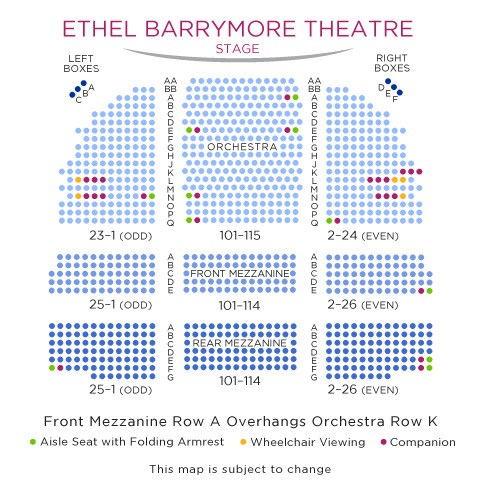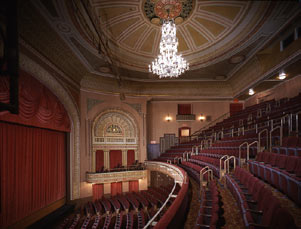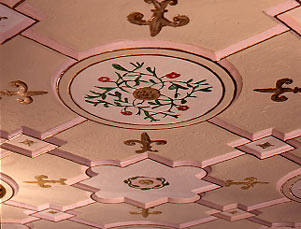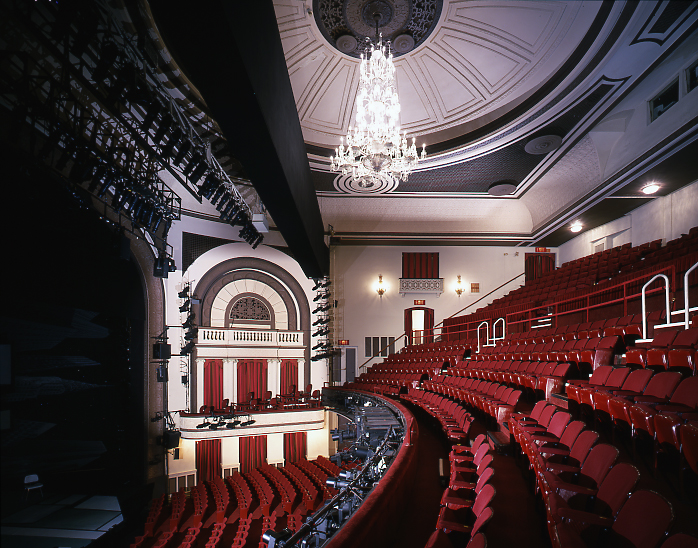HISTORY
The Ethel Barrymore Theatre is the only surviving theatre of the many Lee and J.J. Shubert built for performers who were affiliated with them. Ethel Barrymore was part of the renowned Barrymore acting dynasty, and her tremendous popularity in New York and London society established her as a household name in the US and England. She had achieved stardom under the management of producer Charles Frohman beginning in 1901. In 1928, the Shuberts offered to build her a theatre and commission a play for her to premiere in her namesake house.
ARCHITECTURE
The Barrymore is the last theatre Lee and J.J. Shubert built. Designed by Herbert Krapp, its exterior was modeled on the design of public baths in Rome, with a two-story terra-cotta grillwork screen. The interior decor combines Elizabethan, Mediterranean, and Adamsesque styles. The most elaborate interior element is the boxes, which feature a sunburst pattern over a columned portico.
Spotlight on Broadway: Ethel Barrymore Theatre from Spotlight on Broadway on Vimeo.
Details on the Barrymore Theatre's Accessibility
Access InformationTheatre is wheelchair accessible.Shubert Audience Services
The Barrymore Theatre provides accommodations for patrons who are blind, deaf, partially sighted, and/or have hearing loss. The theatre provides infrared assistive listening devices for every performance at the theatre. In addition, beginning four weeks after a show’s official opening night performance, hand-held audio description devices and hand-held captioning devices are available, and there is unlimited access to downloadable audio description and/or captioning for personal mobile devices free of charge. (Hand-held devices are limited, although additional devices can be obtained with at least twenty-four hours’ notice.) If you have questions, contact Shubert Audience Services at 212-944-3700 or audienceservices@shubertorg.com. There is also a representative at the Shubert Audience Services kiosk at every performance to assist any patron with any of our devices, software, or technology.Accessibility by Seating SectionOrchestra: Seating is accessible to all parts of the Orchestra without steps. Wheelchair seating is located in the Orchestra only. Mezzanine (second level): 3 flights of stairs up 30 steps. Please note, once on the Mezzanine level there are approximately 2 steps per row. Entrance to Mezzanine is behind row E of the Front Mezzanine. Handrails: Available at the end of every stepped seat row in the Mezzanine.
Wheelchair | Companion Seat Locations:
Orchestra: L20 | K20 - 24; L18 | L12 - 14 | L19 | L13 - 17; N19 | N13 -17; N20 | N14 - 18
Aisle Seat with Folding Armrest | Companion Locations:
Orchestra: A114 | A113; E101 | E102; E114 | E113; N101 | N102; N1 | N3
Elevators/EscalatorNone availablePay PhoneIn Lobby (Accessible at 54" with utility outler).RestroomThere is 1 (unisex) wheelchair accessible restroom located on the main floor with no steps. Non-accessible restrooms are located down 2 flights of steps (20 steps.) Water FountainTicket Lobby accessible at 36"
Theatre Policies
The use of cameras, recording devices, cell phones, beepers, and other electronic devices during the performance is prohibited. Everyone attending a performance must have a ticket. Latecomers will be seated at the discretion of management. Wheelchair and mobility-impaired seating is intended for patrons with mobility disabilities. Children under the age of four years will not be admitted. No outside food or beverage permitted, unless medically necessary. No weapons permitted on the premises.
Ethel Barrymore’s premiere at her theatre was The Kingdom of God in December 1928. In April, she opened in another vehicle, The Love Duel (1929), and then toured the country in both, not returning to her theatre until Scarlett Sister Mary (1930). She followed this with a revival of The School for Scandal (1931), her last show under her Shubert contract. Her final appearance at her theatre was in 1940, in An International Incident.
Even without Barrymore herself, the theatre was home to many successes in the 1930s and 40s. Fred Astaire starred in Cole Porter’s Gay Divorce (1932), and Noel Coward wrote, produced and staged two plays with Alfred Lunt and Lynne Fontanne: Design for Living (1933) and Point Valaine (1935). Other notable productions include Death Takes a Holiday (1929), Clare Booth Luce’s The Women (1936), Rodgers and Hart’s Pal Joey (1940) starring Gene Kelly, and Tennessee William’s A Streetcar Named Desire (1947) with Jessica Tandy and Marlon Brando.
The second half of the 20th century proved even more star-studded. Jessica Tandy and Hume Cronyn played in The Fourposter (1951), Anthony Perkins received a Tony nomination for his role in Look Homeward, Angel (1957), Sidney Poitier and Ruby Dee starred in Lorraine Hansberry’s A Raisin in the Sun (1959), Lee Remick appeared inWait Until Dark (1966), Robert Duvall starred in David Mamet’s American Buffalo (1977), and August Wilson presented his Tony Award winning Best Play Joe Turner’s Come and Gone (1988). Among other prominent shows and performers at the at the Barrymore were Peter Shaffer’s Lettice & Lovage (1990), starring Maggie Smith and produced by the Shubert Organization, and Wendy Wasserstein’s The Sisters Rosenzweig (1993), with a scene-stealing performance by Madeline Kahn. Kathleen Turner and Jude Law came to Broadway in Indiscretions (1995) and Dame Judi Dench starred in David Hare’s Amy’s View (1999).
Other productions at the Barrymore include an acclaimed revival of Tom Stoppard’s The Real Thing (2000); Charles Busch’s comedy The Tale of the Allergist’s Wife (2000) starring Linda Lavin; Oscar Wilde’s Salome (2003) with Al Pacino, Marissa Tomei, Dianne Wiest, and David Strathairn; the Tony Award winning revival of Stephen Sondheim’s Company (2006); More recent productions include Exit the King (2009) starring Tony Award winner Geoffrey Rush and Susan Sarandon, and David Mamet's Race (2009). In 2012, the Barrymore was the home to the Tony Award winning revival of Death of a Salesman, starring Philip Seymour Hoffman, followed by the Tony Award winning productions of A Raisin in the Sun (2014), The Curious Incident of the Dog in the Night-Time (2014) and The Band's Visit (2017).
THEATRE SPECS
Barrymore Theatre
243 West 47th Street
Between Broadway and 8th Avenue
New York, NY 10036
| Year Built |
|
1928 |
| |
| Seating Capacity |
|
|
| Orchestra |
|
582 |
| Front Mezzanine |
|
196 |
| Rear Mezzanine |
|
256 |
| Boxes |
|
24 |
| |
|
|
| Total |
|
1058 |
| |
|
|
| Included in Numbers Above: |
|
|
| Orchestra Pit |
|
33 |
| Wheelchair |
|
5 |
| Aisle Transfer Arm |
|
11 |
| |
| Theatre Dimensions |
|
| Proscenium Opening: |
39' 3" |
| Height of Proscenium: |
24' 10" |
| Depth to proscenium: |
28' 3" |
| Depth to front of stage: |
31' 3" |
| Stage Type: |
Proscenium |
| |
SEATING CHART














